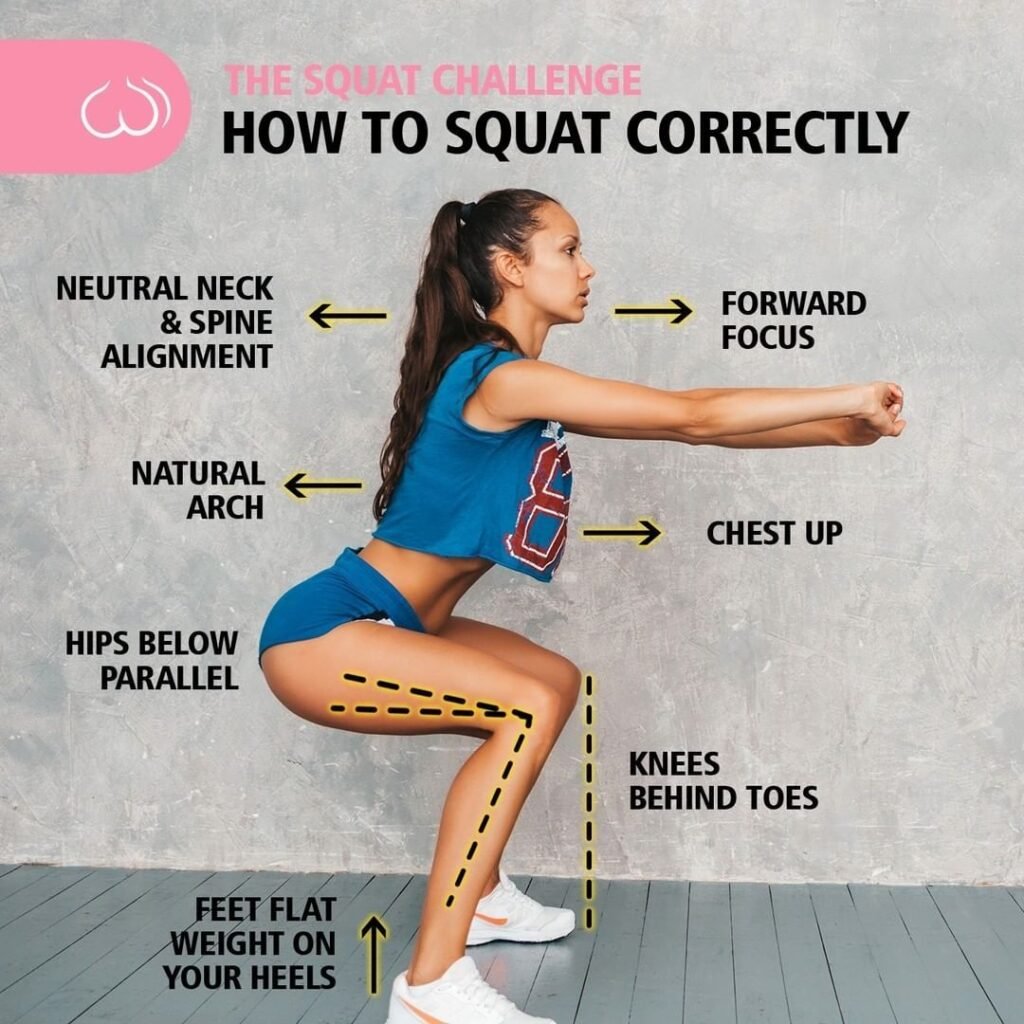
Squats are one of the most fundamental exercises in strength training, known for their ability to build lower body strength and enhance overall fitness. This guide will explore essential techniques for proper squat form, common mistakes to avoid, and effective training tips to help you achieve a stronger lower body workout.
The Importance of Squats
Squats are a compound exercise that engages multiple muscle groups, including:
- Quadriceps: The primary muscles targeted during squats.
- Hamstrings: Assist in stabilizing the movement.
- Glutes: Key for hip extension and overall power.
- Core: Engaged to maintain stability and balance throughout the movement.
Incorporating squats into your workout routine not only strengthens these muscle groups but also improves mobility, enhances athletic performance, and promotes better posture.
Essential Techniques for Proper Squat Form
1. Stance and Setup
- Foot Position: Stand with your feet shoulder-width apart or slightly wider. Your toes should point slightly outward (about 15-30 degrees) to allow for proper knee tracking.
- Bar Placement: If using a barbell, position it on the upper back (trapezius muscles) rather than on the neck. Ensure your grip is comfortable and balanced.
2. Executing the Squat
- Initiate the Movement: Begin by pushing your hips back as if you are sitting in a chair. Bend at the knees while keeping your chest up and eyes looking forward.
- Depth of Squat: Aim to lower your hips until they are below your knees (breaking parallel). This full range of motion engages more muscle fibers and promotes better strength development.
- Knee Tracking: Ensure your knees track in line with your toes throughout the squat. Avoid letting them cave inward, as this can lead to injury.
- Return to Standing: Push through your heels and extend your hips and knees simultaneously to return to the starting position. Lock out your knees at the top while maintaining a neutral spine.
3. Breathing Technique
- Inhale deeply before descending into the squat to create intra-abdominal pressure, which stabilizes your core.
- Exhale as you push back up to standing. This helps maintain control throughout the movement.
Common Mistakes to Avoid
1. Improper Depth
Many lifters perform partial squats due to lack of flexibility or fear of losing balance. However, not squatting low enough limits muscle engagement and strength gains. Aim for full depth while maintaining proper form.
2. Knees Caving In
Allowing your knees to collapse inward during squats can lead to knee injuries over time. Focus on pushing your knees outward in line with your toes throughout the movement.
3. Leaning Forward
A forward lean can place excessive stress on the lower back. Keep your chest lifted and shoulders back to maintain an upright torso position.
4. Rounding the Back
Avoid rounding your upper or lower back during squats, as this increases injury risk. Engage your core and maintain a neutral spine throughout the movement.
5. Using Excessive Weight Too Soon
Progressing too quickly in weight can compromise form and lead to injuries. Start with bodyweight or lighter weights until you are confident in your technique before adding more load.
Effective Training Tips for Stronger Squats
1. Warm-Up Properly
A thorough warm-up prepares your muscles and joints for squatting:
- Include dynamic stretches focusing on the hips, legs, and core.
- Perform light bodyweight squats or dynamic movements like leg swings.
2. Incorporate Variations
To target different muscle groups and improve overall strength:
- Try variations such as goblet squats, front squats, or single-leg squats.
- These variations can help address weaknesses and improve balance.
3. Focus on Mobility
Improving flexibility in the hips, ankles, and thoracic spine can enhance squat depth and form:
- Incorporate mobility exercises like hip openers or ankle stretches into your routine.
4. Use Progressive Overload
Gradually increase weights or repetitions over time:
- Track your progress using a workout log or app.
- Aim for small increments (2.5–5 lbs) each week while maintaining proper form.
5. Rest and Recovery
Allow adequate recovery time between squat sessions:
- Muscles need time to repair and grow stronger after intense workouts.
- Consider incorporating rest days or lighter training weeks into your routine.
Conclusion
Mastering the squat requires attention to detail regarding form, awareness of common mistakes, and a commitment to consistent practice. By following these essential techniques, avoiding pitfalls, and employing effective training strategies, you can develop a stronger lower body while minimizing injury risk. Embrace squats as a vital component of your fitness journey, and enjoy the benefits they bring to overall strength and performance!
